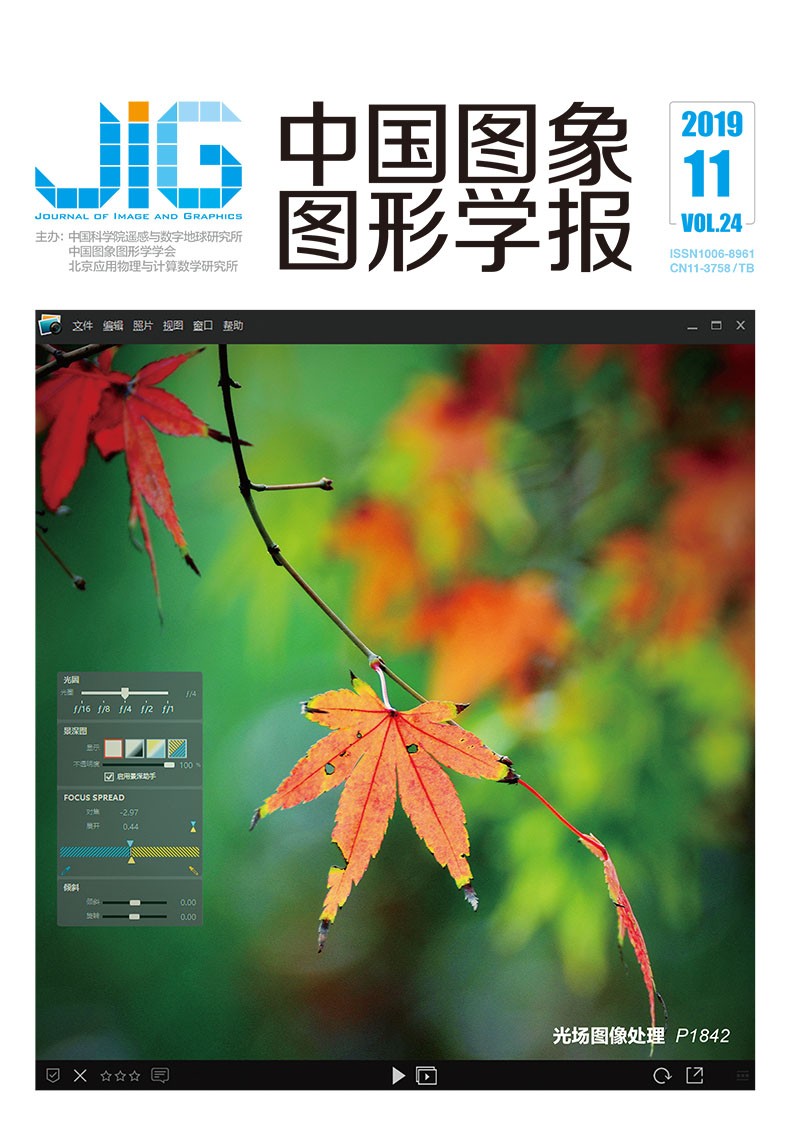
同态滤波下RGB-D点云配准方法
苏本跃1,2, 储小玉1,2, 盛敏2,3(1.安庆师范大学计算机与信息学院, 安庆 246133;2.安徽省智能感知与计算重点实验室, 安庆 246133;3.安庆师范大学数学与计算科学学院, 安庆 246133) 摘 要
目的 为了提高彩色物体配准的精度,针对3维点云颜色信息易受光照条件影响的问题,提出一种基于光照补偿的RGB-D(RGB Depth)点云配准方法。方法 引入同态滤波算法,并将模型对象的3维点云转化成线性点序列,从而对颜色信息进行光照补偿,以提高颜色信息的一致性;获取模型的颜色和几何特征并加权组合成混合特征,以此定义源点云的特征点,并运用K近邻算法搜索其对应点;用奇异值分解(SVD)得到配准的刚性变换矩阵。结果 进行传统的迭代最近点法(ICP)算法、深度信息与色调相结合的算法以及本文算法在不同的光照强度组合的模型配准对比实验,结果显示,在网面凹凸均匀的大卫模型上,配准时间及特征点匹配平均误差方面均约减少到对比方法的1/2;在网面光滑的barrel模型和网面凹凸不一致的阿基米德模型上,特征点匹配平均误差约分别减少到对比方法的1/6和1/8。此外,与Super 4-Points Congruent Set(Super 4PCS)、彩色点云配准算法在不同组合光照强度下进行对比实验,针对4种不同的网面结构模型,本文算法的SIFT特征点距离平均误差全距约减少到对比方法的1/5。结论 利用同态滤波算法抑制光照影响,提高了颜色信息的一致性,在一定效果上消除了光照强度不均匀对3维点云配准精度的干扰。
关键词
RGB-D point cloud registration method via homomorphic filtering
Su Benyue1,2, Chu Xiaoyu1,2, Sheng Min2,3(1.School of Computer and Information, Anqing Normal University, Anqing 246133, China;2.Key Laboratory of Intelligent Perception and Computing of Anhui Province, Anqing 246133, China;3.School of Mathematics and Computational Science, Anqing Normal University, Anqing 246133, China) Abstract
Objective Digital restoration of historical cultural relics, simulation of medical equipment and human organs, and virtual teaching reflect that 3D reconstruction technology plays an extremely important role in the development level of human society. However, in 3Dreconstruction, geometric data in the RGB-D (RGB Depth) data collected by a depth camera have low quality and high noise. In 3D point cloud registration, the features of geometric data obtained from such low-quality and high-noise data are the only means to obtain an accurate registration result of the point cloud. However, the point cloud registration effect is not particularly obvious. Given that point cloud noise interference is relatively large and geometric information is unclear, which has a non-negligible effect on the registration accuracy. Color information is introduced to increase the feature information of the model. However, when the model data are collected by as canning device, the color is greatly affected by a change in illumination, and the model surface is affected by changes in illumination intensity and angle of view. These effects lead to an obvious color change and inevitable interference. In this study, an RGB-D point cloud registration method based on illumination compensation is proposed that considers 3D point cloud color information as susceptible to illumination conditions. Method The color data of the model surface consist of the product of illumination and reflection components. The illuminance component varies with spatial position and displays low-frequency information, where as the reflected component has various texture details visible to the human eye and expresses high-frequency information. The brightness of low-frequency information of color is suppressed when combined with homomorphic filtering, the amount of high-frequency information is enhanced, the influence of color changes by illumination is eliminated, and the consistency of color information is improved. RGB-D data acquired by a Kinect device must be sorted to form a linear point sequence. The color and geometric features of the model are acquired and weighted into a mixed feature to define the feature points of the source point cloud, and the K-nearest neighbor algorithm is used to search for the corresponding points. The singular value decomposition algorithm is used to obtain a rigid transformation matrix. Result Through experiments, data are collected from four models at different light intensities using Kinect scanning equipment. The experimental categories comprise three sets, namely, strong light and low light, left light and right light, and strong light and side light. Our method is compared with the traditional iterative closest point (ICP), super four-point congruent set(Super 4PCS), 4D ICP (hue + ICP) combined with hue and geometry information, and blending of geometric and color information. In the course of the experiments, the iteration running time, number of iterations, and average distance error of scale-invariant feature transform (SIFT) feature points are used as the evaluation criteria for the registration experiment results. The effects of different light intensity models after registration by each algorithm are also shown for comparison. Results according to the traditional ICP algorithm, the combination of depth information and hue, and the model registration experiment of different light intensity combinations on the David model with uniform mesh surface show that the times are relatively flat; the average running times are 8.920 s, 8.796 s, and 5.191 s; and the average errors of feature point matching are 3.677, 3.102,and 1.029, respectively. Registration time and average error of feature point matching are improved by approximately 50%. On the Archimedes model with inconsistent mesh surface irregularities, the number of iterations is undistinguishable. The average running times of the registration are 6.926 s, 3.955 s and 3.853 s, and the average errors of feature point matching are 26.718, 27.653, and 28.843, respectively. On the barrel model with smooth mesh surface, the average running times of registration are 0.509 s, 1.937 s and 0.691 s, and the average errors of feature point matching are 23.830, 22.820, and 3.931, respectively. On the barrel model with smooth mesh surface and the Archimedes model with inconsistent mesh surface irregularities, the average error of feature point matching is reduced to one-sixth and one-eighth of the comparison method. This study also compares the Super 4PCS and color point cloud registration algorithms under different combined illumination intensities. Of the four mesh structure models, the average distance error of SIFT feature points of the proposed algorithm is the lowest. The full-distance reduction is reduced to one-fifth of the comparison method, which proves that the proposed algorithm has stability in the model registration of different illumination intensities. This study further conducts correlation experiments on the missing point cloud model and proves that the algorithm can deal with the problem of point cloud registration with missing points. When the overlap rate of two point clouds is approximately 40%, the algorithm registration in this study can achieve better results. Conclusion Homomorphic filtering algorithm is used to suppress the influence of illumination changes, and the consistency of color information is improved. The interference of uneven illumination intensity on 3D point cloud registration accuracy is eliminated. The registration method is verified by comparing it with other correlation registration algorithms. The method has obvious advantages in algorithm stability and registration accuracy.
Keywords
RGB-D data light compensation HSV space homomorphic filtering mixed characteristics point cloud registration
|



 中国图象图形学报 │ 京ICP备05080539号-4 │ 本系统由
中国图象图形学报 │ 京ICP备05080539号-4 │ 本系统由